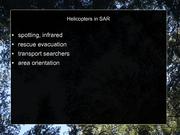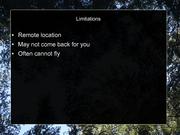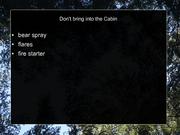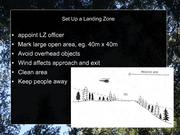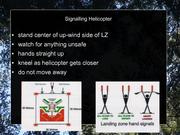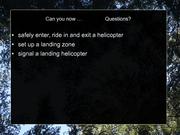SAR Fundamentals/Helicopter
From PCSAR
Contents |
[edit] Subject
What is this lesson plan about?
Helicopter in SAR
[edit] Authors
List who wrote this lesson plan.
Brett Wuth
[edit] Scope
What is included in this lesson, what's not and why.
- SAR Fundamentals Manual: Ch.29 "Helicopter in SAR"
- Basic SAR Skills Manual: F-6 "Helicopter Operations"
[edit] Objectives
At the conclusion of this lesson the participants:
- will be able to ...
[edit] Time Plan
Total Time: 45 minutes
- 2005-02: 60 min
- 2011-03: 42 min
- 2013-02: 43 min
| Time | Material
|
|
00:00 3 min |
Introduce topic title Introduce Instructor Present Objectives |
|
00:03
|
play Helicoper Operation video - both parts
|
|
|
Use of helicopter in SAR?
|
|
|
Limitations
|
|
|
Some stuff may have to go in tail storage
|
|
|
|
|
|
distribute STARS LZ card creating landing zone
|
|
|
signaling
|
|
|
Questions |
[edit] Aids
What materials are needed or useful in presenting this lesson.
- non published material
- Helicopter Operations video
- STARS landing zone info card
- slides (download/print: .pdf; edit: .odp)
[edit] Question bank
List of questions suitable for an review/exam of this section.
See Question bank
[edit] Frequently Asked Questions
What are some of the questions that students typically ask. Include the answers.
[edit] Feedback
When has this lesson been presented. What was the feedback.
[edit] License
What can others do with this lesson?
Copyright (c) 2012, Brett Wuth. This work is licensed under a Creative Commons Attribution-NonCommercial 2.5 Canada License. To view a copy of this license, visit http://creativecommons.org/licenses/by-nc/2.5/ca/ or send a letter to Creative Commons, 559 Nathan Abbott Way, Stanford, California 94305, USA.
[edit] Reference Material
If you need to cite sources, do so here.
[1]
[edit] Notes
Any additional notes, etc.
Ideas:
- landing zones
- what to expect as helicopter coming in
- trust pilot
- hand signals
- slinging gear in / out
- loading helicopter
- stacks of gear
- using people to keep weight down
- hearing protection
- theory of operations
- how they get lift
- temperature
- identify types of helicopters and their abilities
- different services and abilities, e.g STARS and Alpine


